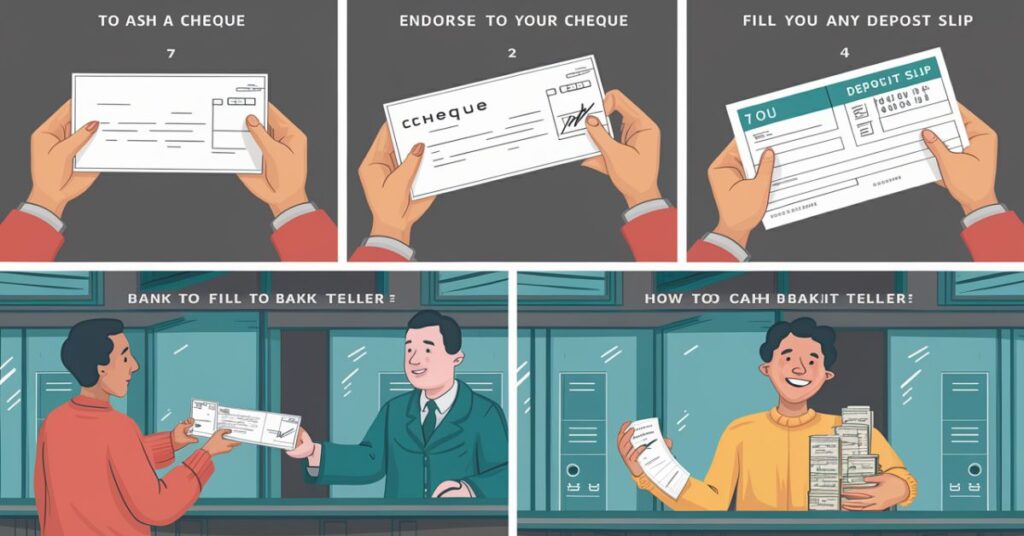HOW TO CASH A CHEQUE Cashing a Cheque is simple. First, endorse the back. Then, visit your bank or a check-cashing location. Present the cheque and valid ID. The teller will verify and process it. Finally, receive your cash or deposit it into your account.
HOW TO CASH A CHEQUE Ever wondered how to transform a piece of paper into cold, hard cash. It’s simpler than you think. Picture yourself walking into the bank, cheque in hand. With a smile, you hand it over to the teller, and moments later, you’re walking out with money in your pocket. Intrigued.
To cash a Cheque, go to your bank. Give it to the teller. Show your ID. Wait for verification. Receive your money.
How to Cash a Check without a Bank Account?

Cashing a check without a bank account may seem daunting, but it’s possible with a few simple steps. First, look for a check-cashing store or retailer that offers this service. Bring your check and a valid form of identification, like a driver’s licence or state ID. The cashier will verify the check and may charge a fee for the service. Once verified, you’ll receive the cash amount minus the fee.
Alternatively, consider using a prepaid debit card. Many stores offer check cashing services and can load the funds onto a prepaid card for immediate use. Just be sure to read the terms and conditions, as fees may apply. With these options, you can access your money quickly and conveniently, even without a traditional bank account.
Recmonded this post:CAN UNIVERSAL CREDIT CHECK MY BANK ACCOUNT?
Options for Cashing in Cheques without a Bank Account
If you don’t have a bank account, you still have options for cashing in cheques. One option is to visit a check-cashing store or retailer. You’ll need to bring your cheque and a valid ID, like a driver’s licence. The cashier will verify the Cheque and may charge a fee. Another option is to use a prepaid debit card. Many stores offer cheque cashing services and can load the funds onto a prepaid card for immediate use. Just be aware of any fees that may apply. With these options, you can access your money without needing a bank account.
Steps
1. Locate a check-cashing store or retailer that offers cheque cashing services.
2. Bring your Cheque and a valid form of identification, such as a driver’s licence or state ID.
3. Present the Cheque to the cashier and provide your ID for verification.
4. The cashier will verify the Cheque and may charge a fee for the service.
5. Once verified, you will receive the cash amount of the cheque minus any applicable fees.
6. Alternatively, consider using a prepaid debit card if the store offers this option.
7. If using a prepaid card, the cashier may load the funds onto the card for immediate use.
8. Be sure to review and understand any fees associated with the cheque cashing service or prepaid card usage.
9. After completing the transaction, you’ll have access to the funds without needing a traditional bank account.
Cashing a Cheque at Your Own Bank
If you have an account with the bank that issued the cheque, the easiest way to cash it is by visiting your own bank. Simply bring the cheque and your identification to the teller, who will verify the cheque and process the transaction. You may receive the funds immediately or within a few business days, depending on the bank’s policies.

Making Sure a Cheque is Cashable
Before attempting to cash a Cheque, it’s important to ensure that it’s cashable. Look for essential elements such as a date, payee name, signature, and amount written in both words and figures. Additionally, make sure the cheque is not post-dated or stale-dated, as banks may refuse to cash such cheques.
Cheque Encashment Validity
Cheque encashment validity refers to the timeframe during which a cheque can be presented to the bank for payment. Generally, cheques have a validity period, typically ranging from three to six months from the date of issuance. Beyond this period, the cheque may be considered stale or expired, and the bank may refuse to honour it.
The validity period serves to ensure the efficiency and security of financial transactions. It also helps prevent fraud and misuse of cheques. If a cheque remains uncashed beyond its validity period, the issuer can choose to reissue a new cheque to the payee.
It’s important for both issuers and recipients of cheques to be aware of the validity period to avoid any inconvenience or complications in the encashment process. Banks strictly adhere to these validity periods as part of their standard operating procedures to maintain the integrity of the banking system. Therefore, it’s advisable to encash cheques promptly within their validity period to avoid any potential issues.
Cashing a Cheque in Other Ways
If you don’t have a bank account or prefer not to cash the Cheque at your own bank, there are alternative methods available.
1. Visit a cheque-cashing service
Check-cashing services specialise in cashing various types of cheques for a fee. Locate a reputable cheque-cashing service in your area, bring your cheque and identification, and the cashier will verify the cheque and provide you with the cash amount, minus any applicable fees.
2. Check your nearest retailer or grocery store
Many retailers and grocery stores offer Cheque cashing services for their customers. Simply visit the customer service desk or designated cheque-cashing area, present your cheque and identification, and the cashier will assist you in cashing the cheque for a fee.
3. Use a prepaid debit card
Consider using a prepaid debit card if you prefer not to carry cash or if you don’t have a bank account. Some cheque-cashing services and retailers offer the option to load the funds from your cheque onto a prepaid debit card. Once loaded, you can use the card to make purchases, pay bills, or withdraw cash from ATMs. Be sure to review any associated fees before opting for this method.
Do I need an ID to cash a check?

Yes, you typically need to present a valid form of identification when cashing a Cheque. This helps verify your identity and ensures that you are the rightful recipient of the funds. Acceptable forms of ID may include a driver’s licence, state ID, passport, or other government-issued identification. It’s always a good idea to have your ID ready when cashing a Cheque to expedite the process and avoid any delays.
To cash a check, you typically need to present a valid form of identification. This could be a driver’s licence, state ID, passport, or other government-issued ID. The purpose of providing ID is to verify your identity and ensure that you are the rightful recipient of the funds.
Without proper ID, the check-cashing establishment may not be able to process the transaction. It’s always a good idea to have your ID ready when cashing a check to avoid any delays or complications.
Have a question you want to ask our legal experts?
If you have a legal question or concern, don’t hesitate to reach out to our team of legal experts for assistance. Whether it’s regarding cheque bouncing, endorsing cheques, or any other legal matter, we’re here to help. Simply submit your question through our contact form or reach out to us directly, and one of our knowledgeable experts will provide you with guidance and support.
Related Resources
Related resources provide additional information, tools, or resources that complement the content of the article or post. They may include links to related articles, downloadable guides or templates, recommended books or websites, or other relevant resources. By exploring related resources, readers can deepen their understanding of the topic and access further insights or assistance.
- Online Banking Tutorials
- Financial Literacy Guides
- Check Fraud Prevention Tips
- Budgeting Tools and Templates
- Bank Customer Service Hotline Numbers
- Personal Finance Blogs and Websites
- Government Financial Assistance Programs
- Investment Planning Workshops
- Credit Report Monitoring Services
- Financial Planning Books
Cheque Truncation System
Cheque Truncation System (CTS) is a process used by banks to fast-track the cheque clearing process. Instead of physically transporting cheques between banks, CTS allows for electronic images of cheques to be exchanged and processed. This reduces the time and cost associated with cheque clearing and enhances efficiency and security in the banking system.
Crossed Cheque
A crossed cheque is a cheque that has two parallel lines drawn across its face. This indicates that the cheque can only be deposited into a bank account and cannot be cashed over the counter. Crossing a cheque adds an extra layer of security by ensuring that the funds are deposited directly into the intended recipient’s account.
Cheque Bouncing
Cheque bouncing occurs when a cheque is presented for payment but is returned unpaid by the bank due to insufficient funds, account closure, or other reasons. This can have legal consequences for the drawer of the cheque, including potential criminal charges or civil liabilities. It’s important to ensure that you have sufficient funds in your account before issuing a cheque to avoid bouncing.
Who can file a case for cheque bouncing?
In the case of cheque bouncing, the payee or holder of the bounced cheque can file a case against the drawer of the cheque. This typically involves issuing a legal notice to the drawer demanding payment of the bounced amount within a specified period. If the payment is not made, the payee can proceed to file a criminal complaint or civil suit against the drawer.
Endorsing cheques
Endorsing a cheque involves signing the back of the cheque to transfer ownership or to deposit it into a bank account. Different types of endorsements may be used depending on the intended recipient and purpose of the cheque. It’s important to endorse cheques carefully and accurately to ensure that they are processed correctly by banks or other financial institutions.
Order Cheque
An order cheque is a type of cheque that is payable to a specific person or entity named on the face of the cheque. It cannot be transferred to another party and must be deposited into the payee’s bank account. Order cheques provide added security by ensuring that the funds are delivered directly to the intended recipient.
Open a Huntington Checking Account
To open a Huntington Checking Account, you’ll need to visit a Huntington branch or apply online. Bring your identification and a form of payment for the initial deposit. Once your account is open, you can start using it to cash cheques, make deposits, and manage your finances. Huntington offers various checking account options to suit your needs, so you can choose the one that’s right for you.
Encash a cheque
To encash a Cheque, simply take it to your bank or a check-cashing store. Present the cheque and your identification to the teller, who will verify the cheque and process the transaction. Once verified, you’ll receive the cash amount of the cheque minus any applicable fees. Encashing a Cheque is a convenient way to access funds quickly.
Bearer Cheque
A bearer cheque is a type of cheque that is payable to the bearer, meaning it can be cashed by anyone who presents it to the bank. Bearer cheques are risky because they can be lost or stolen and cashed by unauthorised individuals. It’s important to handle bearer cheques with caution and ensure their safekeeping.
Account Payee Cheque
An account payee cheque is a type of cheque that is crossed with the words “account payee” written between the parallel lines. This indicates that the funds are to be deposited directly into the payee’s bank account and cannot be cashed over the counter. Account payee cheques provide added security by ensuring that the funds are delivered safely to the intended recipient’s account.
Digital Cheque Deposit
Digital Cheque Deposit is a convenient banking service that allows individuals to deposit cheques electronically without visiting a physical bank branch. With this service, users can simply capture an image of the front and back of the cheque using their smartphone or computer, and then upload it through the bank’s mobile app or online banking portal.
The cheque image is securely transmitted to the bank for processing, eliminating the need to physically deliver the cheque. Once the Cheque is verified, the funds are deposited into the user’s account, providing a fast and efficient way to access funds without the hassle of visiting a bank branch.
Bank/ATM Dropbox Deposit

Bank and ATM dropbox deposit services allow you to deposit cheques or cash without having to visit a teller or ATM. Simply insert your deposit into the designated dropbox, and it will be processed by the bank. This convenient option saves time and allows you to make deposits outside of regular banking hours.
ATM Deposit
ATM deposit allows you to deposit cheques or cash directly into your bank account using an ATM machine. Simply insert your debit card, follow the on-screen instructions to select the deposit option, and insert your deposit into the designated slot. The ATM will process the deposit and provide you with a receipt for your records.
Bank Deposit
Bank deposit refers to the process of depositing funds into your bank account through a branch, ATM, or online banking. Simply visit your bank branch or ATM, fill out a deposit slip, and provide the funds to be deposited. Alternatively, you can use online banking to transfer funds electronically into your account. Bank deposits are a safe and convenient way to store and manage your money.
For Direct Cheque Deposit Facility
The Direct Cheque Deposit Facility allows individuals to deposit cheques directly into their bank accounts without the need for physical branch visits. To utilise this service, the cheque must be crossed and made payable to the payee.
The payee can then deposit the cheque at any branch of the Paying/Drawee Bank, requesting the transfer of funds into their account through online channels such as RTGS customer fund transfer, Over The Counter (OTC) IBFT, or the bank’s internal online system if both the payer and payee banks are the same.
The payee is required to provide their IBAN, account title, CNIC, and mobile number on the back of the cheque for identification purposes. Upon verification/validation of the cheque instrument by the Paying/Drawee branch, an acknowledgement of the received instrument is provided.
The Paying/Drawee bank may conduct a call back confirmation with the payer to ensure the authenticity of the instrument and the identity of the payee. Upon verification, the Paying/Drawee bank transfers the funds through either RTGS MT102 or OTC IBFT to the payee’s account.
Recomanded also this post:What Is CCI CARE.COM Charge on Bank Statement | Explained
Conclusion
Cashing a Cheque is a simple process that offers flexibility and convenience. By exploring various options such as check-cashing stores, prepaid debit cards, or traditional bank visits, individuals can access their funds without a bank account. It’s essential to ensure the Cheque’s validity and have proper identification when cashing.
Each method has its advantages and potential fees, so it’s crucial to weigh the options carefully. Regardless of the chosen method, prioritising security and authenticity is paramount to avoid any complications. With the right approach and understanding of available alternatives, cashing a cheque becomes a straightforward task accessible to everyone needing quick access to funds.
FAQ,s
1. Can you cash a Cheque at any bank?
Yes, you can usually cash a Cheque at any bank, but some banks may charge a fee if you’re not a customer.
2. Can I cash a Cheque for money?
Yes, you can cash a Cheque for money at banks, check-cashing stores, or retail locations that offer Cheque cashing services.
3. How do I cash a Cheque at an ATM?
You can deposit a cheque at an ATM by inserting your debit card, selecting “Deposit,” and following the on-screen instructions to insert the cheque.
4. Can a cheque be deposited in any bank?
Yes, you can deposit a cheque into any bank, but you may need an account with that bank. Some banks may charge a fee for non-customers.
5. How to cash a Cheque online?
To cash a cheque online, use your bank’s mobile app or website to deposit the cheque electronically into your account.
6. How to cash a cheque sbi?
You can cash a cheque with SBI by visiting any State Bank of India branch or using their online banking services.
7. Can I Cash a Cheque at any Bank?
Yes, you can cash a Cheque at any bank, but non-customers may be charged a fee for the service.

I am constantly seeking new challenges and opportunities to make a positive impact through my work. With my passion for innovation and drive for success, i continues to push the boundaries of what is possible in the ever-evolving world of technology.
In addition to my technical skills, I am known for my strong communication and leadership abilities. I thrives in collaborative environments, where i can leverage my expertise to drive projects forward and inspire teams to achieve their goals.







